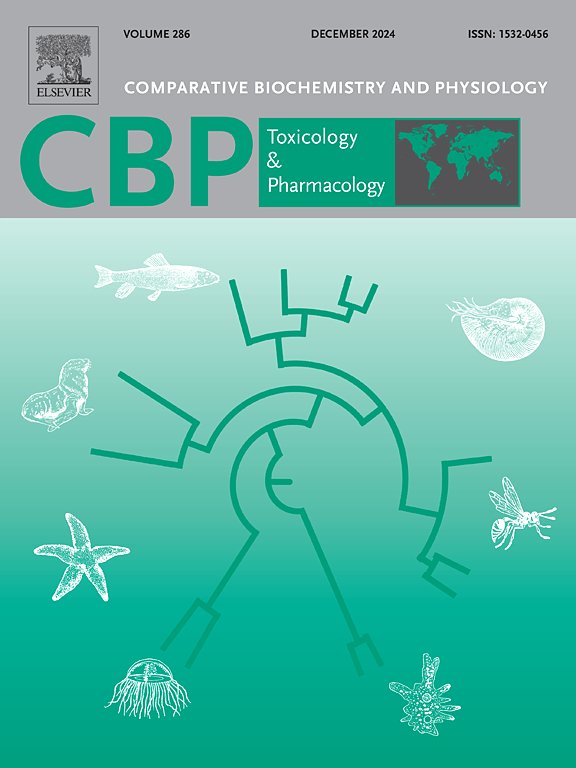The combined effect of environmentally relevant doses of glyphosate and high temperature: An integrated and multibiomarker approach to delineate redox status and behavior in Danio rerio
IF 3.9
3区 环境科学与生态学
Q2 BIOCHEMISTRY & MOLECULAR BIOLOGY
Comparative Biochemistry and Physiology C-toxicology & Pharmacology
Pub Date : 2024-12-06
DOI:10.1016/j.cbpc.2024.110095
引用次数: 0
Abstract
Glyphosate, a pesticide commonly found in aquatic ecosystems, affects this habitat and nontarget organisms such as fish. The increase in water temperature, linked to factors such as climate change, poses a considerable threat. Despite extensive ecotoxicological research, we still do not know the real individual and specific consequences of continued exposure to glyphosate and high temperatures, simulating a scenario where the aquatic environment remains contaminated and temperatures continue to rise. Therefore, in this study, we examined the effects of exposure to environmentally relevant concentrations of glyphosate, active ingredient glyphosate (GAI), and glyphosate-based herbicide (GBH) in combination with high temperature (34 °C) in adult zebrafish (Danio rerio). The fish were acclimated to 28 or 34 °C for 96 h. The exposure to 225 and 450 μg L−1 (GBH or GAI) at 28 or 34 °C for 7 days. We analyzed behavioral endpoints (anxiety-like response, sociability, and aggressivity) and biochemical biomarkers of the brain and muscle (oxidative stress). Anxiety-like responses and decreased sociability were disrupted by the combination of glyphosate and high temperature. Furthermore, there is a decrease in Acetylcholinesterase activity in the brain, and an increase in Lipid Peroxidation, Protein Carbonylation, Acetylcholinesterase activity, and Glutathione S-Transferase activity in the muscle. These results demonstrated oxidative stress, anxiety-like behavior and decreased sociability caused by glyphosate and high temperature. We concluded that the combined effects of glyphosate and high temperature affected redox homeostasis and behavior, emphasizing that the field of glyphosate pollution should be carefully considered when evaluating the effects of climate change.

环境相关剂量草甘膦和高温的综合效应:一种综合的多生物标志物方法来描述斑马鱼的氧化还原状态和行为。
草甘膦是水生生态系统中常见的一种农药,它会影响这种栖息地和鱼类等非目标生物。与气候变化等因素有关的水温升高构成了相当大的威胁。尽管进行了广泛的生态毒理学研究,但我们仍然不知道持续暴露于草甘膦和高温下的真实个体和具体后果,模拟水生环境仍然受到污染且温度继续上升的情景。因此,在本研究中,我们研究了暴露于环境相关浓度的草甘膦、活性成分草甘膦(GAI)和草甘膦除草剂(GBH)以及高温(34 °C)对成年斑马鱼(Danio rerio)的影响。鱼被驯化在28或34 °C下96 h。在28或34 °C下暴露于225和450 μg -1 (GBH或GAI) 7 天。我们分析了行为终点(类焦虑反应、社交能力和攻击性)和大脑和肌肉的生化生物标志物(氧化应激)。焦虑样反应和社交能力下降被草甘膦和高温联合破坏。此外,脑内乙酰胆碱酯酶活性降低,而肌肉内脂质过氧化、蛋白质羰基化、乙酰胆碱酯酶活性和谷胱甘肽s -转移酶活性增加。这些结果表明草甘膦和高温引起氧化应激、焦虑样行为和社交能力下降。我们得出结论,草甘膦和高温的联合作用影响氧化还原稳态和行为,强调在评估气候变化的影响时应仔细考虑草甘膦污染领域。
本文章由计算机程序翻译,如有差异,请以英文原文为准。
求助全文
约1分钟内获得全文
求助全文
来源期刊
CiteScore
7.50
自引率
5.10%
发文量
206
审稿时长
30 days
期刊介绍:
Part C: Toxicology and Pharmacology. This journal is concerned with chemical and drug action at different levels of organization, biotransformation of xenobiotics, mechanisms of toxicity, including reactive oxygen species and carcinogenesis, endocrine disruptors, natural products chemistry, and signal transduction with a molecular approach to these fields.

 求助内容:
求助内容: 应助结果提醒方式:
应助结果提醒方式:


